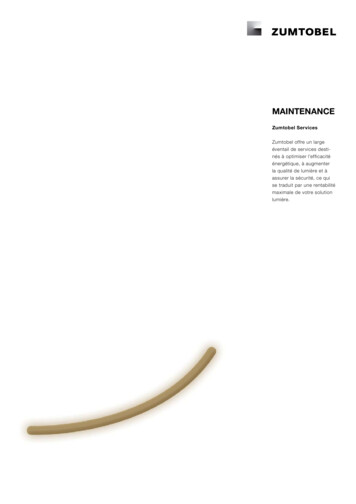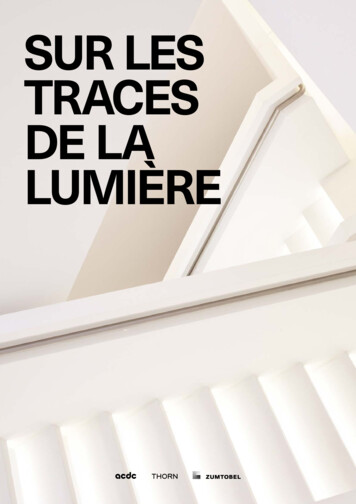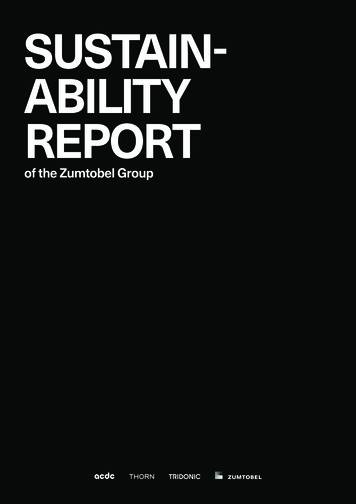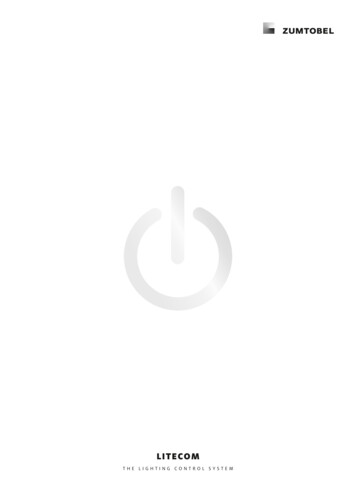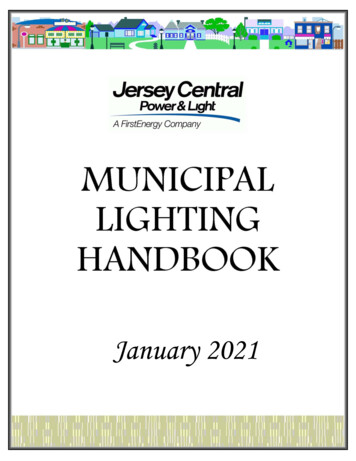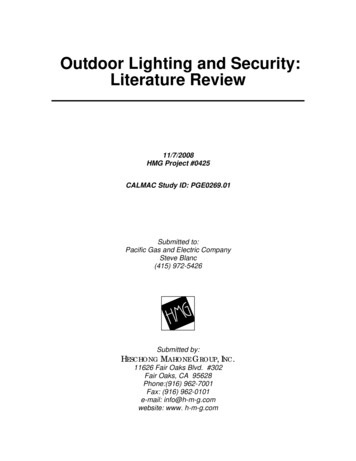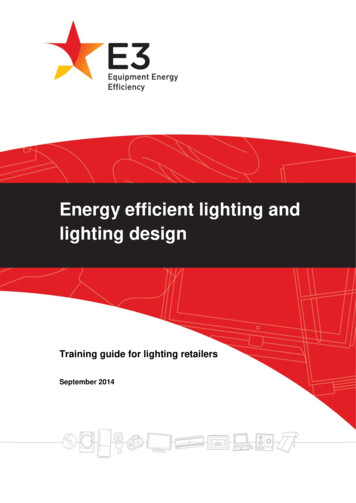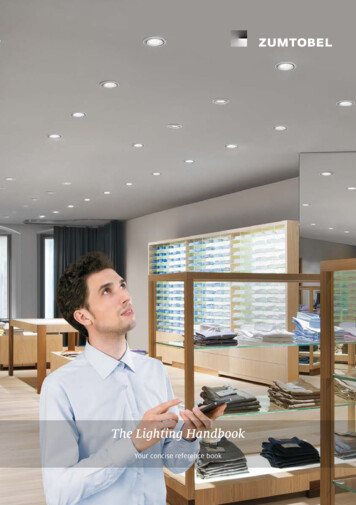
Transcription
The Lighting HandbookYour concise reference book
Chapter 1Lighting technologyChapter 2Standard values for indoor and outdoor lightingBased on the new European standardsChapter 3Lighting applicationChapter 4TechnologyChapter 5LampsChapter 6Lighting control and control gearChapter 7Emergency lightingChapter 8Technology and tablesChapter 9Design tools
ImprintFor questions and suggestions on“The Lighting Handbook”Zumtobel Lighting GmbHSchweizer Strasse 30Postfach 726851 Dornbirn, AUSTRIAT 43/(0)5572/390-0info@zumtobel.info6th edition: April 2018
1Chapter 1Lighting technologyWhat is light?What does the human eye see?Human Centric LightingLight has a triple effect6788Basic parameters used in lightingLuminous fluxLuminous intensityIlluminanceLuminance1011111111Quality characteristics of lightingThe right light – traditional and new quality criteriaIlluminance – definition of terminologyGlare – glare limitationThe UGR methodIlluminance levels on ceilings and wallsSpatial illuminationLight colourColour rendering1212141517171818Measuring illuminance19Outdoor lighting20Types of lighting22Lighting concepts24Energy efficiency in buildings26The Lighting Handbook
6What is light?Light is that part of the electromagnetic spectrum that isperceived by our eyes.The wavelength range is between380 and 780 nm. The cones come on during the day and wesee colours, whereas at night the rods take over and we onlysee shades of grey.What is the melanopic effect of light?The retina also contains photosensitive ganglion cells.These are sensitive to blue light and suppress the sleephormone melatonin at night. Melatonin is responsible for agood sleep at night. Suppressing melatonin in the morninghelps keep you awake during the day. This means that theright light controls the circadian rhythm thus a healthywaking and sleeping behaviour.What is light?Wavelength [m]10 -10Gamma raysX-raysUltravioletLight10 -5InfraredTerahertzMicrowaves100Television, VSWMedium wave105The Lighting HandbookRadio waves
7What does the human eye see?Relative spectral perception of brightness and melanopic effectEffect as a percentageNightSmel(λ) V'( λ)100DayV( ion of the three curves:V(λ) Perception of brightness, daytime seeing with the conesV'(λ) Night-time seeing with the rodsSmel(λ) Melatonin suppression with the photosensitive ganglion cellsλWavelength [nm]The Lighting Handbook780Wavelength [nm]
8What is light?Human Centric LightingHuman Centric Lighting (HCL) expresses the positive effect oflight and lighting on the health, well-being and performanceof humans and thus has both short and long-term benefits.Light has a triple effectLight for visual functions– Illumination of task area in conformitywith relevant standards– Glare-free and convenientLight for emotional perception– Lighting enhancing architecture– Creating scenes and effectsLight creating biological effects– Supporting people’s circadian rhythm– Stimulating or relaxingThe Lighting Handbook
9The Lighting Handbook
10Basic parameters used in lightingLuminous flux – Luminous intensity – Illuminance – LuminanceLuminous flux ΦΙ ΦΩE ΦALumen [lm]Luminous intensity ΙIlluminance ECandela [lm/sr] [cd]Lux [lm/m2 ] [lx]Luminance LL ΙA L · cosL [lm/sr*m2 ] [cd/m2 ]Ω solid angle into which luminous flux is emittedA area hit by luminous fluxAL · cos visible areas of light sourceρ reflectance of area 3.14* for diffuse surface areasThe Lighting HandbookE · ρ*
11Luminous fluxThe luminous flux describes the quantity of light emittedby a light source.The luminous efficiency is the ratio of the luminous fluxto the electrical power consumed (lm/W). It is a measureof a light source’s economic efficiency.Abbreviation: Φ PhiUnit: lm LumenLuminous intensityThe luminous intensity describes the quantity of light thatis radiated in a parti cular direction. This is a useful measurement for directive lighting elements such as reflectors. It isrepresented by the luminous inten sity distribu tion curve(LDC).Abbreviation: ΙUnit: cd CandelaIlluminanceIlluminance describes the quantity of luminous flux falling ona surface. Relevant standards specify the required illuminance(e.g. EN 12464 “Lighting of indoor workplaces”).Illuminance: E(lx) Abbreviation: Eluminous flux (lm)area (m2)Unit: lx LuxLuminanceLuminance is the only basic lighting para meter that isperceived by the eye.It describes on the one hand a light source’s impression ofbrightness, and on the other, a surface and therefore depends toa large extent on the degree of reflection (colour and surface).Abbreviation: LUnit: cd/m2The Lighting Handbook
12Quality characteristics of lightingThe right light – traditional and new quality criteriaTraditional quality criteria– Sufficient illumination level– Harmonious brightness distribution– Glare limitation– Avoidance of reflections– Good modelling– Correct light colour– Appropriate colour renderingNew quality criteria– Changing lighting situations– Personal control– Energy efficiency– Daylight integration– Light as an interior design elementIlluminance – definition of terminologyIlluminance maintenance value ĒmValue below which the illuminance level mustnot fall in the visual task area.Visual task areaIlluminance levels are specified for specificvisual tasks and are designed for the area inwhich these may take place.If the exact location is unknown, the roomas a whole or a defined area of the work station is used for specification.The visual task area may be a horizontal,vertical or inclined plane.Area immediately surrounding the visualtask areaHere illuminance may be one level lower thanin the visual task area (e.g. 300 lx to 500 lx).The Lighting HandbookMaintenance factorThe initial value multiplied by the maintenance factor gives the illuminancemaintenance value.The maintenance factor can be determinedindividually, and takes the installation’sreduction in luminous flux caused by soilingand ageing of lamps, luminaires and roomsurfaces into account.The maintenance schedule (the cleaningand maintenance intervals for the lamps andinstallation) must be documented.See also Section 9 – Checklists.Uniformity UOIn order to perform visual tasks in illuminatedareas, there should not be any great differences in brightness so that uniformity shouldnot fall below UO Emin/Ē.
13Relative illuminance (%)– Initial value150125– Maintainedilluminance with3-year cleaning100– System value without maintenance75502501234Maintenance value maintenance factor x initial valueReflectance factorsThe reflectance factors of the room andobject surfaces determine not only theperception of the room but also the reflectedlight and thus the room’s brightness.The reflectance factor table in the systemhelps you determine the reflectance factors.The Lighting Handbook5Operating time(years)
14Quality characteristics of lightingGlare – glare limitationDirect glareReflected glareCause– Luminaires without glare control– Very bright surfacesCause– Reflective surfaces– Incorrect luminaire arrangement– Incorrect workstation positionEffect– Loss of concentration– More frequent mistakes– FatigueEffect– Loss of concentration– More frequent mistakes– FatigueRemedy– Luminaires with limited luminance levels– Blinds on windowsThe evaluation of glareThe glare of all luminaires that are in theroom regularly can be evaluated with theUGR method, as specified in the standardEN 12464-1 “Lighting of indoor workplaces”.However LED luminaires with very brightlight points, which can be perceived indi vidually, are crucial.The Lighting HandbookRemedy– Matching luminaire to workstation (layout)– Indirect lighting– Matt surfacesClassic VDU workstation luminairesThe standard requires the luminance of theluminaire to be below 3000 or 1500 cd/m2 atan angle of 65 .
15The UGR methodThe standardised UGR method (unified glarerating) is used to assess (psychological) glare.The UGR value is calculated with a formula.This takes into account all of the luminairesin the system that contribute to the impression of glare. The UGR values for luminairesare determined using the table methodpursuant to CIE 117. Zumtobel quotes both aUGR reference value for a reference roomand the UGR tables for other room sizes forthe majority of luminaires in its data sheetsand on their website.UGR limits (UGRL) that must not beexceeded: 16 Technical drawing 19 Reading, writing, training, meetings,computer-based work 22 Craft and light industries 25 Heavy industry 28 Railway platforms, foyersThe UGR limits are specified in theEN 12464 standard for activities and visualtasks (see tables on pages 31–41).The UGR tables are available for each luminaire via the respective photometric datasheet: Select a product Photometry Select a layoutThe values are hereby used for a classification on a glare level. A comparison of indi vidual values does not allow any statement.Example: 18.5 is 19 (level) but not betterthan 19.0 (same glare level 19).Note: the glare value RG is used outdoors.It is explained in the standard EN 12464-2.(UGR 8 log 0,25 L2ΩP2Lb(1)(2))The UGR method takes account of thebrightness of walls and ceilings (1) as well asall luminaires in the system that contribute tothe sensation of glare (2). The result is aUGR index.The Lighting Handbook
16Quality characteristics of lighting 45 85 13UGRLQuality classA1231619222528for nominal illuminance (lx)1000 750 5002000 1500 1000750 300500 3002000 1000 500 3002000 1000 500 30085 8643A75 65 255 45 8 10323 4 5 6 8 104ahs123 4Luminance L in cd/m2The luminance limit curve method assessesthe mean luminance of a luminaire from aviewing angle of 45 to 85 .The new European standard sets UGR 19as the maximum permissible value foroffices, which is equivalent to the luminancelimiting curve for 500 lx in Quality class 1.The Lighting HandbookThe limit value method was used in theformer standard DIN 5035 to assess the glare.
17Illuminance levels on ceilingsand wallsUnlit ceilings and walls create an unpleasantroom impression. Bright surfaces, however,pleasantly enhance the room climate.The EN 12464 standard thereforerequires an illuminance level of at least 30 lxor 50 lx* on ceilings and at least 50 lx or75 lx* on walls. In fact, these levels ought tobe sig nificantly exceeded and should be atleast 175 lx on walls.* in offices, class rooms, hospitalsSpatial illuminationIn order to enhance people’s and objects’recognisability in a room, basic requirementsare placed on cylindrical illuminance ĒZ andmodelling.Hence, ĒZ should be as high as 150 lx inrooms used for communication.Modelling is the ratio between cylindricaland horizontal illuminance at a specific pointand should be between 0.3 and 0.6.ĒZThe Lighting Handbook
18Quality characteristics of lightingLight colourThe light colour describes the colourappearance of the light.ww (warm white)Colour temperatureAppearanceAssociationup to 3300 Kreddishwarmnw (intermediate white)3300–5300 Kwhiteneutraltw (cool white)from 5300 KbluishcoolIn addition to the colours of the surfaces, it is also thelight colour that determines a room’s basic atmosphere!Please refer to Chapter 4 – Technology for light colours oflight sources and changes to the light colour.Colour renderingColour rendering is the ability of a lightsource to reproduce surface colours(8 test colours R1 to R8) as faithfully aspossible compared to a reference lightsource. It is identified by the colour renderingindex (CRI). The best colour rendering isRa 100.Light sources are divided up into colourrendering levels:Ra 90 very good colour renderingRa 80 good colour renderingColour rendering of less than 80 should notbe selected at workplaces.If light sources with a colour renderingindex below 80 are used in exceptional cases,it has to be ensured that safety colours canbe recognised without any problems.The Lighting HandbookThe saturated test colours R9 to R14 arealso used occasionally to describe specialfunctions of a light source. The reproductionof these colours is then quoted separately.LightR1 greyish redLightR 5 blueish greenDarkR 2 greyish yellowR 6 Light blueStrongR 3 yellow greenR7 Light violetModerateR 4 yellowish greenLightR 8 reddish purpleR 9 Strong redR12 Strong blueR10 Strong yellowLightR13 yellowish pinkR11 Strong greenModerateR14 olive green (leaf)
19Measuring illuminanceThe Mean illuminance is the arithmeticbrilliance level measured with a luxmeterin a defined grid, under precisely specifiedconditions.Measuring instruments:Description and precision– L: maximum precision, tolerance 3 %– A: high precision, tolerance 5 %– B: average precision; tolerance 10 %(minimum requirement)Measuring grid and measuring levelIn order to facilitate inspection of the light‑ing system, the measuring grid has beenspecified in the EN 12464 (Lighting of workplaces) and EN 12193 (Lighting of sportsfacilities) standards.Measuring conditions– Avoid external light/daylight(measure separately and subtract)– Check mains voltage and ambienttemperature– Use new, burnt-in lamps (dischargelamps 100 h)The following recommendations apply for theheight of the measuring levels:– Workplaces 0.75 m;sports facilities (floor) 0.03 m– Circulation areas, stairs,car parks (floor) 0.03 m– Cylindrical illuminance 1.2 m– Measuring grid: congruent triangles– Measuring grid not congruent withluminaire layout gridSize of measuring fieldGrid element spacing1m0.2 m5m0.6 m10 m1m50 m3m100 m5mThe Lighting Handbook
20Outdoor lightingThe following aspects have to be taken into account for theillumination of squares and parks, buildings and facades:– targeted illumination of the areas to be visualised,both horizontal and vertical– creation of a three-dimensional perception of the roomthrough different brightness levels and shades– balanced brightness distribution– avoidance of strong dark-light contrasts– limitation of the glare effect for r
– Light as an interior design element Maintenance factor The initial value multiplied by the mainte-nance factor gives the illuminance maintenance value. The maintenance factor can be determined individually, and takes the installation’s reduction in luminous flux caused by soiling and ageing of lamps, luminaires and room surfaces into account.
